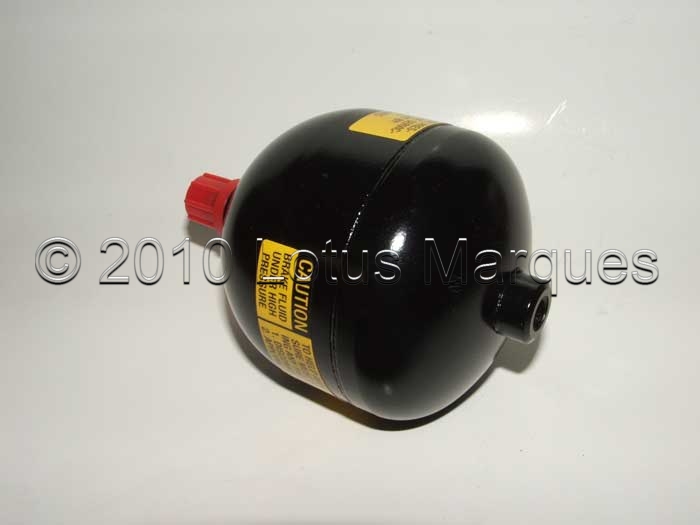If you are experiencing problems with ABS system and the check light illuminates on the dash board, then the accumulator may have a reduced pre-charge pressure.
Under normal operating conditions the accumulator stores brake fluid supplied by the pump which is maintained at a high pressure of between 2200psi and 2700psi.
If the accumulator is diagnosed as being faulty, the replacement procedure should be followed as per Section JF.18, page 63 in the Lotus Service Notes (Braking System including Delco Moraine ABS 111A)

To Replace Accumulator
NOTE: The accumulator is a nitrogen-charged pressure vessel which holds brake fluid under high pressure. No re-charging or other repairs can be made.
If the pre-charge is diagnosed a being low (section JF.14) the unit must be replaced.
1. Depressurise the accumulator by turning off the ignition and FIRMLY applying the brake pedal 40 times. A noticeable change in the pedal feel (to a hard pedal) will occur when the accumulator is completely discharged.
2. Unscrew the accumulator from the endplate using a 17mm socket. (this maybe be a different type of fastener for after-market accumulators)
3. Fit a new ‘O’ ring on the accumulator spigot and lubricate with DOT 4 fluid.
Screw the accumulator into the endplate and tighten to 31 – 35 Nm (23 – 25 lb.ft)
4. Bleed the brake system as in JF.8
Under normal operating conditions the accumulator stores brake fluid supplied by the pump which is maintained at a high pressure of between 2200psi and 2700psi.
If the accumulator is diagnosed as being faulty, the replacement procedure should be followed as per Section JF.18, page 63 in the Lotus Service Notes (Braking System including Delco Moraine ABS 111A)

To Replace Accumulator
NOTE: The accumulator is a nitrogen-charged pressure vessel which holds brake fluid under high pressure. No re-charging or other repairs can be made.
If the pre-charge is diagnosed a being low (section JF.14) the unit must be replaced.
1. Depressurise the accumulator by turning off the ignition and FIRMLY applying the brake pedal 40 times. A noticeable change in the pedal feel (to a hard pedal) will occur when the accumulator is completely discharged.
2. Unscrew the accumulator from the endplate using a 17mm socket. (this maybe be a different type of fastener for after-market accumulators)
3. Fit a new ‘O’ ring on the accumulator spigot and lubricate with DOT 4 fluid.
Screw the accumulator into the endplate and tighten to 31 – 35 Nm (23 – 25 lb.ft)
4. Bleed the brake system as in JF.8





